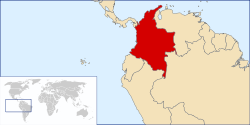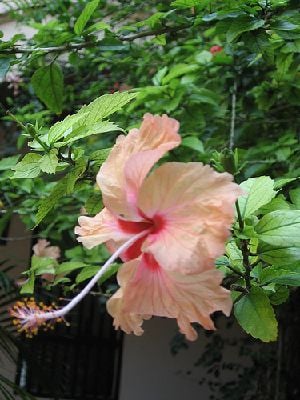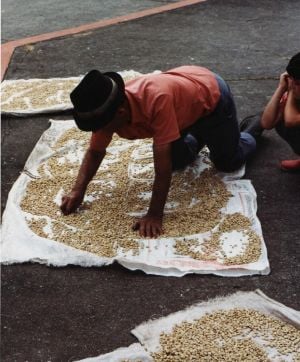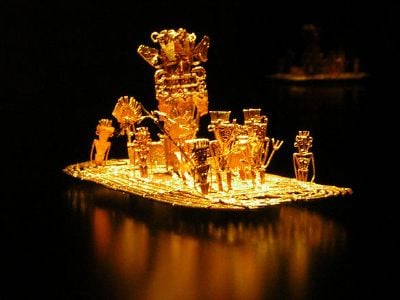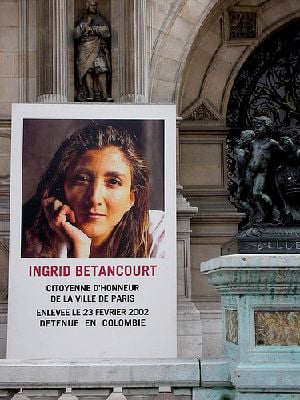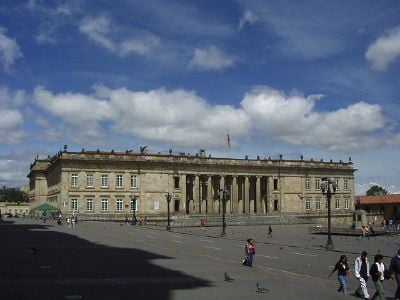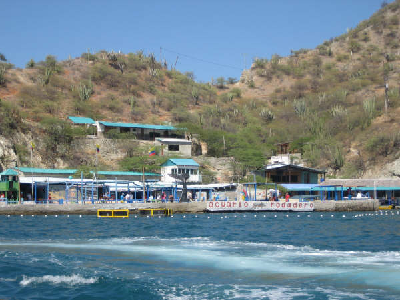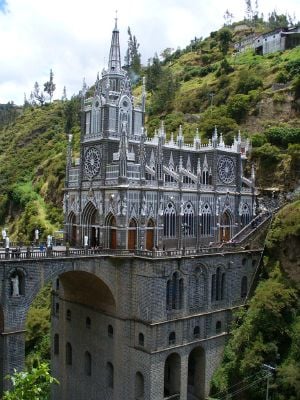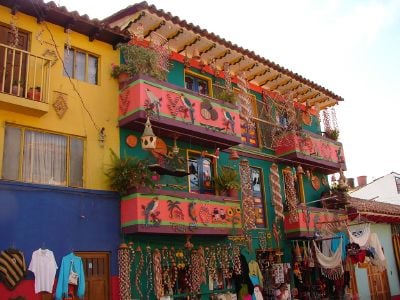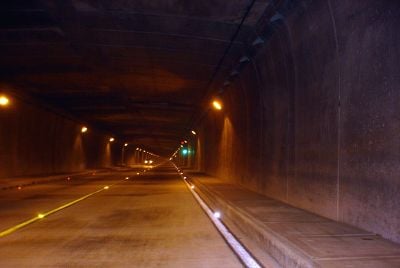Colombia
| República de Colombia Republic of Colombia |
||||||
|---|---|---|---|---|---|---|
|
||||||
| Motto: "Libertad y Orden" (Spanish) "Freedom and Order" |
||||||
| Anthem: ¡Oh, Gloria Inmarcesible! (Spanish) O unfading glory! |
||||||
| Capital (and largest city) | Bogotá 4°39′N 74°3′W | |||||
| Official languages | Spanish1 | |||||
| Recognized regional languages | The 72 languages and dialects of ethnic groups are also official in their regions.[1] | |||||
| Ethnic groups | 87.6% White or Mestizo 6.8% Afro-Colombians (includes Mulatto, Raizal, and Palenquero) 4.3% Amerindian 1.4% Unspecified[2] |
|||||
| Demonym | Colombian | |||||
| Government | Unitary presidential republic | |||||
| - | President | Gustavo Petro | ||||
| - | Vice President | Francia Márquez | ||||
| Independence | from Spain | |||||
| - | Declared | July 20, 1810 | ||||
| - | Recognized | August 7, 1819 | ||||
| - | Current constitution | 1991 | ||||
| Area | ||||||
| - | Total | 1,141,748 km² (26th) 440,831 sq mi |
||||
| - | Water (%) | 8.8 (17th) | ||||
| Population | ||||||
| - | 2021 estimate | 50,355,650[2] (29th) | ||||
| - | Density | 42.23/km² (173rd) 105.72/sq mi |
||||
| GDP (PPP) | 2022 estimate | |||||
| - | Total | |||||
| - | Per capita | |||||
| GDP (nominal) | 2022 estimate | |||||
| - | Total | |||||
| - | Per capita | |||||
| Gini (2020) | 54.2[4] | |||||
| Currency | Peso (COP) |
|||||
| Time zone | (UTC-52) | |||||
| Internet TLD | .co | |||||
| Calling code | [[++57]] | |||||
| 1 | Although the Colombian Constitution specifies Spanish as the official language in all its territory, the native languages (approximately 88 dialects) are also official in the whole country. | |||||
| 2 | The official Colombian time, is controlled and coordinated by the state agency Superintendency of Industry and Commerce.[5] | |||||
Colombia, officially the Republic of Colombia, is a country located in the northwestern region of South America. It is bordered to the east by Venezuela and Brazil, to the south by Ecuador and Peru, to the north by the Atlantic Ocean (through the Caribbean Sea), and to the west by Panama and the Pacific Ocean. It is the only South American country with both Atlantic and Pacific coasts.
Colombia is the 26th largest nation in the world and the fourth-largest country in South America (after Brazil, Argentina, and Peru), with an area more than twice that of France.
The country suffers from low-intensity conflicts involving rebel guerrilla groups, paramilitary militias, drug traffickers, and corruption. The conflict originated around 1964-1966, when the Revolutionary Armed Forces of Colombia (FARC) and the National Liberation Army (ELN) were founded and began their guerrilla insurgency campaigns against successive Colombian government administrations.
The word "Colombia" comes from the name of Christopher Columbus (Cristóbal Colón in Spanish, Cristoforo Colombo in Italian). Originally a reference to the New World, especially to all American territories and colonies under Spanish and Portuguese rule, the name was adopted by the Republic of Colombia of 1819 formed by the union of Venezuela, New Granada, and Ecuador.
In 1830, when Venezuela and Ecuador separated, the region that remained became a new country: The Republic of New Granada. In 1863 New Granada changed its name to United States of Colombia, and in 1886 adopted its present name: Republic of Colombia.
Geography
Colombia has more physical diversity packed into its borders than any other area of comparable size in Latin America. The country is part of the Pacific Ring of Fire, a region of the world characterized by frequent earthquakes and volcanic eruptions.
Colombian surface features form complicated patterns. The western third of the country is the most complex. Starting at the shore of the Pacific Ocean in the west and moving eastward, a diverse sequence of features is encountered. In the extreme west are the very narrow and discontinuous Pacific coastal lowlands, which are backed by the Serranía de Baudó, the lowest and narrowest of Colombia's mountain ranges. Next is the broad region of the Río Atrato/Río San Juan lowland, which has been proposed as a possible alternate to the Panama Canal as a man-made route between the Atlantic and Pacific Oceans.
The chief western mountain range, the Cordillera Occidental, is a moderately high range with peaks reaching up to about 13,000 ft (4,000 m). The Cauca River Valley, an important agricultural region with several large cities on its borders, separates the Cordillera Occidental from the massive Cordillera Central. Several snow-clad volcanoes in the Cordillera Central have summits that rise above 18,000 ft (5,500 m). The valley of the slow-flowing and muddy Magdalena River, a major transportation artery, separates the Cordillera Central from the main eastern range, the Cordillera Oriental. The peaks of the Cordillera Oriental are moderately high. This range differs from Colombia's other mountain ranges in that it contains several large basins. In the east, the sparsely populated, flat to gently rolling eastern lowlands called llanos cover almost 60 percent of the country's total land area.
This cross section of the republic does not include two of Colombia's regions: the Caribbean coastal lowlands and the Sierra Nevada de Santa Marta, both in the northern part of the country. The lowlands in the west are mostly swampy; the reed-filled marshes of the area are called ciénagas. The Guajira Peninsula in the east is semiarid. The Sierra Nevada is a spectacular triangular snowcapped block of rock that towers over the eastern part of this lowland.
Climate
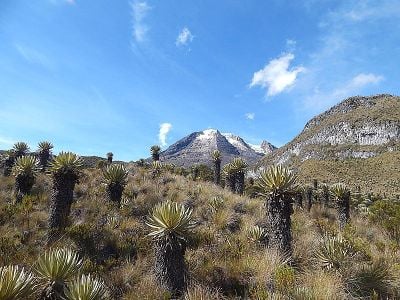
Colombia's proximity to the equator influences its climates. The lowland areas are continuously hot, but altitude greatly affects temperature. Mountain climate is one of the unique features of the Andes and other high altitude reliefs where climate is determined by elevation. Below 1,000 meters (3,281 ft) in elevation is the warm altitudinal zone, where temperatures are above 24 °C (75.2 °F). About 82.5 percent of the country's total area lies in the warm altitudinal zone. The temperate climate altitudinal zone located between 1,001 and 2,000 meters (3,284 and 6,562 ft) is characterized for presenting an average temperature ranging between 17 and 24 °C (62.6 and 75.2 °F). The cold climate is present between 2,001 and 3,000 meters (6,565 and 9,843 ft) and the temperatures vary between 12 and 17 °C (53.6 and 62.6 °F). Beyond lies the alpine conditions of the forested zone and then the treeless grasslands of the páramos. Above 4,000 meters (13,123 ft), where temperatures are below freezing, the climate is glacial, a zone of permanent snow and ice.
Rainfall varies by location in Colombia, tending to increase as one travels southward. This is especially true in the eastern lowlands. For example, rainfall in parts of the Guajira Peninsula seldom exceeds 30 in (75 cm) per year. Colombia's rainy southeast, however, is often drenched by more than 200 in (500 cm) of rain per year. Rainfall in most of the rest of the country lies between these two extremes.
Vegetation
Altitude affects not only temperature but also vegetation. In fact, altitude is one of the most important influences on vegetation patterns in Colombia. The mountainous parts of the country can be divided into several vegetation zones according to altitude, although the altitude limits of each zone may vary somewhat depending on the latitude.
The "tierra caliente" (hot land), below 3,300 ft (1,000 m), is the zone of tropical crops such as bananas. The tierra templada (temperate land), extending from an altitude of 3,300 to 6,600 ft (1,000 to 2,000 m), is the zone of coffee and maize.
Wheat and potatoes dominate in the "tierra fría" (cold land), at altitudes from 6,600 to 10,500 ft (2,000 to 3,200 m). In the "zona forestada" (forested zone), which is located between 10,500 and 12,800 ft (3,200 and 3,900 m), many of the trees have been cut for firewood. Treeless pastures dominate the páramos, or alpine grasslands, at altitudes of 12,800 to 15,100 ft (3,900 to 4,600 m). Above 15,100 ft (4,600 m), where temperatures are below freezing, is the "tierra helada," a zone of permanent snow and ice.
Vegetation also responds to rainfall patterns. A scrub woodland of scattered trees and bushes dominates the semiarid northeast. To the south, savanna (tropical grassland) vegetation covers the Colombian portion of the llanos. The rainy areas in the southeast are blanketed by tropical rainforest. In the mountains, the spotty patterns of precipitation in alpine areas complicate vegetation patterns. The rainy side of a mountain may be lush and green, while the other side, in the rain shadow, may be parched.
History
Pre-Columbian era
The first humans are believed to have arrived in the area from Central America about 20,000 B.C.E. Circa 10,000 B.C.E., hunter-gatherer societies existed near present-day Bogotá that traded with one another and with cultures living in the Magdalena River Valley.[6] Further waves of Mesoamericans—indigenous peoples of Central America—arrived between 1,200 and 500 B.C.E. and introduced maize. The Chibcha people came from present-day Nicaragua and Honduras between 400 and 300 B.C.E. They grew potatoes, corn, and other crops; developed irrigation systems; mined emeralds and salt; and built roads and suspension bridges.
Within Colombia, the two cultures with the most complex power structures were the Tayronas on the Caribbean coast and the Muiscas in the highlands around Bogotá, both of which were of the Chibcha language family. The Muisca people are considered to have had one of the most developed political systems in South America, after the Incas.[7]
Colonial era
Spanish explorers made the first exploration of the Caribbean littoral in 1500 led by Rodrigo de Bastidas. Christopher Columbus navigated near the Caribbean in 1502. In 1508, Vasco Nuñez de Balboa began the conquest of the territory through the region of Urabá. In 1513, he was also the first European to discover the Pacific Ocean, which he called Mar del Sur (or "Sea of the South") and which in fact would bring the Spaniards to Peru and Chile.
In 1510, the first European city in the Americas was founded, Santa María la Antigua del Darién. The territory's main population was made up of hundreds of tribes of the Chibchan and "Carib," currently known as the Caribbean people, whom the Spaniards conquered through warfare. Resulting disease, exploitation, and the conquest itself caused a tremendous demographic reduction among the indigenous peoples. In the sixteenth century, Europeans began to bring slaves from Africa.
Independence from Spain
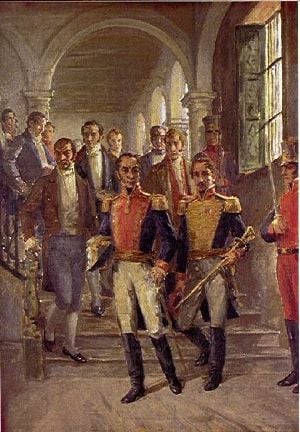
Since the beginning of the periods of conquest and colonization, there were several rebel movements under Spanish rule, most of them either being crushed or remaining too weak to change the overall situation. The last one, which sought outright independence from Spain, sprang up around 1810, following the independence of St. Domingue in 1804 (present-day Haiti), which provided a degree of support to the eventual leaders of this rebellion: Simón Bolívar and Francisco de Paula Santander, who became the first two presidents of Colombia. The rebellion finally succeeded in 1819, when the territory of the Viceroyalty of New Granada became the Republic of Greater Colombia, organized as a confederation along with Ecuador and Venezuela (Panama was part of Colombia).
Political struggle
Internal political and territorial divisions led to the secession of Venezuela and Quito (today's Ecuador) in 1830. At this time, the name New Granada was adopted, which it kept until 1856 when it became the Grenadine Confederation. After a two-year civil war, in 1863, the United States of Colombia was created, lasting until 1886, when the country finally became known as the Republic of Colombia.
Internal divisions remained, occasionally igniting bloody civil wars, the most significant being the Thousand Days civil war (1899-1902). U.S. intentions to build the Panama Canal led to the separation of Panama in 1903 and its establishment as a separate nation. Colombia was also engulfed in a year-long war with Peru over a territorial dispute involving the Amazonas Department and its capital Leticia.
La Violencia
Soon after Colombia achieved a relative degree of political stability, which was interrupted by a bloody conflict that took place between the late 1940s and the early 1950s, a period known as La Violencia ("The Violence"). Its cause was mounting tensions between the two leading political parties, which ignited after the assassination of the Liberal presidential candidate on April 9, 1948. This assassination caused riots in Bogotá. The violence spread throughout the country and claimed the lives of at least 180,000 Colombians. From 1953 to 1964 the violence between the two political parties decreased, first when Gustavo Rojas deposed the president in a coup d'etat and negotiated with the guerrillas, and then under the military junta of General Gabriel París Gordillo.
The National Front
The two main political parties—the Conservative Party and Liberal Party—agreed to create a coalition government. The presidency would alternate between parties every four years; the parties would have parity in all other elective offices. The National Front ended "La Violencia" and attempted to institute far-reaching social and economic reforms in cooperation with the Alliance for Progress. In the end, the contradictions between each successive Liberal and Conservative administration made the results decidedly mixed. Despite progress in certain sectors, many social and political injustices continued. Guerrilla movements including FARC, ELN, and M-19 were created to fight the government and political apparatus.
Colombian armed conflict
During the late 1970s and throughout the 1980s and 1990s, powerful and violent drug cartels emerged, mainly the Medellín Cartel (under the command of Pablo Escobar) and the Cali Cartel, which exerted political, economic, and social influence in Colombia during this period. These cartels also financed and influenced different illegally armed groups across the political spectrum.
To replace the previous 1886 constitution, a new constitution was ratified in 1991 that included key provisions on political, ethnic, human, and gender rights, which have been gradually put in practice, though uneven developments, surrounding controversies, and setbacks have persisted. The new constitution also initially prohibited the extradition of Colombian nationals to the United States. The drug cartels were accused of lobbying in favor of this prohibition and carried out a violent campaign against extradition that included terrorist attacks and mafia-style executions. Drug cartels attempted to influence the government and the political structure of Colombia by means of corruption.
In recent decades, the country has continued to be plagued by the effects of the influential drug trade, guerrilla insurgencies like FARC, and paramilitary groups such as the AUC (later demobilized, though paramilitarism remains active), which, along with other minor factions, have engaged in a bloody internal armed conflict.
Analysts claimed that the drug cartels helped the Colombian trade balance through a steady and substantial influx of foreign currency, mainly U.S. dollars, though other negative economic and social effects also resulted. The drug lords have also destabilized the government.
The different irregular groups often resort to kidnapping and drug smuggling to fund their causes. They tend to operate in the remote rural countryside and can sometimes disrupt communications and travel between regions. Colombia's most famous hostage, especially internationally, was Ingrid Betancourt, a former senator and presidential candidate known as an outspoken and daring anti-corruption activist. She was kidnapped by FARC in 2002, while campaigning for the presidency and was finally rescued by the government in 2008.
Since the early 1980s, attempts at reaching a negotiated settlement between the government and different rebel groups have been made, either failing or achieving only the partial demobilization of some of the parties involved. One of the latest such attempts was made during the administration of President Andrés Pastrana, which negotiated with the FARC between 1998 and 2002.
In the late 1990s, President Andrés Pastrana implemented an initiative named Plan Colombia, with the dual goal of ending the armed conflict and promoting a strong anti-narcotic strategy. The most controversial element of the Plan, which as implemented also included a smaller number of funds for institutional and alternative development, was considered to be its anti-narcotic strategy, consisting of an increase in aerial fumigations to eradicate coca. This activity came under fire from several sectors, which claimed that fumigation also damaged legal crops and has adverse health effects for populations exposed to the herbicides. Critics of the initiative also claim that the plan represents a military approach to problems that have their roots in the social inequalities of the country, and that it causes coca farmers to clear new fields for crops deeper within jungle areas, significantly increasing the rate of deforestation.
During the presidency of Álvaro Uribe, who was elected on the promise of applying military pressure on the FARC and other criminal groups, some security indicators have improved, such as a decrease in reported kidnappings (from 3,700 in 2000 to 800 in 2005) and a decrease of more than 48 percent in homicides between July 2002 and May 2005. It is argued that these improvements have favored economic growth and tourism.
Uribe, who took office in August 2002, is a staunch U.S. ally whose country was the only one in South America to join the U.S.-led coalition in Iraq. He met President George Bush several times, most recently in May 2007.
Government
- Executive branch
- Colombia is a republic where the executive branch dominates the government structure. Until recently, the president was elected together with the vice president by popular vote for a single four-year term; he functioned as both head of government and head of state. However, on October 19, 2005, the Colombian Congress amended the constitution, which now allows Colombian presidents to serve two consecutive four-year terms. However, department governors, mayors of cities and towns, and other executive branch officials are only elected for a three-year term and cannot be immediately re-elected.
- Legislative branch
- Colombia's bicameral parliament consists of a 166-seat Chamber of Representatives and an 102-seat Senate. Members of both houses are elected by popular vote to serve four-year terms. Colombia also elects department deputies and city council members.
- Judicial branch
- In the 1990s, the Colombian judicial system underwent significant reforms and switched from an inquisitorial to an adversarial system. The judicial system is headed by the Constitutional Court and members are appointed by Congress out of nominations made by the president and other high-ranking tribunals.
Administrative divisions
Colombia is divided into 32 departments and one capital district. The departments are subdivided into 1,119 municipalities and have ten districts, the Old Four (Bogota, Barranquilla, Cartagena, and Santa Marta) and the New Six (Tunja, Cucuta, Popayan, Buenaventura, Tumaco, and Turbo).
Economy
After experiencing decades of steady growth (average GDP growth exceeded 4 percent in the 1970-1998 period), Colombia experienced a recession in 1999 (the first full year of negative growth since 1929), and the recovery from that recession was long and painful. Colombia's economy suffers from weak domestic and foreign demand, austere government budgets, and serious internal armed conflicts.
Colombia's main exports include manufactured goods, petroleum, coal , and coffee.
Colombia is also the largest exporter of plantains to the United States. Within Latin America, Colombia is known as a provider of fine lingerie, with the industry being centered in Medellín. All imports, exports, and the general trade balance are in record levels, and the inflow of export dollars has resulted in substantial revaluation of the Colombian peso.
The problems facing the country range from pension system problems to drug dealing to moderately high unemployment (12 percent). Several international financial institutions have praised the economic reforms introduced by current
Tourism
Most tourists come to Colombia during the famous festivals, such as the Cali Fair, the Barranquilla Carnival, the Bogotá summer festival, the Iberoamerican Theater Festival, and the Flower Festival. Many people visit Colombia during the Christmas season and the celebrations surrounding independence day.
Even though Colombia has been plagued with travel advisories because of the activities of FARC and other guerrilla groups, it has continued to attract more tourists.
Demographics
Movement from rural to urban areas was very heavy in the mid-twentieth century but has since tapered off. The urban population increased from 31 percent of the total population in 1938 to 57 percent in 1951 and 70 percent by 1990. The nine eastern lowlands departments, constituting about 54 percent of Colombia's area, have less than 3 percent of the population and a density of less than two persons per square mile (one person per sq km).
The country has a diverse population that reflects its colorful history and the peoples that have lived there from ancient times to the present. The historic amalgam of the different main groups forms the basics of Colombia's current demographics: European immigrants, indigenous natives, Africans, Asians, Middle Easterners, and other recent immigrants. Many of the indigenous peoples were absorbed into the mestizo population, but the remaining 700,000 currently represent over 85 distinct cultures.
The European immigrants were primarily Spanish colonists, but a small number of other Europeans (Dutch, German, French, Swiss, Belgian, and in smaller numbers, Polish, Lithuanian, English, and Croatian communities) immigrated during World War II and the Cold War. For example, former Bogotá mayor Antanas Mockus is the son of Lithuanian immigrants.
Africans were brought as slaves, mostly to the coastal lowlands, beginning early in the sixteenth century and continuing into the nineteenth century. After abolition, a national ideology of mestizaje encouraged the mixing of the indigenous, European, and Native Amerindian communities into a single mestizo ethnic identity.[8] Other immigrant populations include Asians and Middle Easterners, particularly Lebanese, Jordanians, Syrians, Chinese, Japanese, and Koreans.
Indigenous peoples
Before Spanish colonization of the region that would become Colombia, the territory was home to many different indigenous peoples. Today more than 50 different indigenous ethnic groups exist in Colombia. Most of them speak languages belonging to the Chibchan and Cariban linguistic families. The Colombian government has established 567 reserves for indigenous peoples, which are inhabited by more than 800,000 persons. Some of the largest indigenous groups are the Arhuacos, the Muisca, the Kuna, the Witoto, the Páez, the Tucano, the Wayuu, and the Guahibo.
Immigrant groups
Because of its strategic location Colombia has received several immigration waves during its history. Most of these immigrants settled on the Caribbean coast; Barranquilla (the largest city on the Colombian Caribbean coast) has the largest population of Lebanese, Jewish, Italian and Roma descendants. There are also important communities of German and Chinese descendants in that region.
Ethnic groups
The census data in Colombia do not take into account ethnicity, so percentages are basically estimates from other sources and can vary from one another. Statistics reveal that a majority of Colombians are the result of a mixture of Europeans, Africans, and Amerindians.
There are 101 languages listed for Colombia in the Ethnologue database, of which 80 are spoken today, though most of the population speaks Spanish. There are about 500,000 speakers of indigenous languages in Colombia today.
Religion
The government does not collect religious statistics, and accurate reports are hard to obtain. Based on various studies, more than 95 percent of the population adheres to Christianity, most of them (81 to 90 percent) Roman Catholicism. About 1 percent practice indigenous religions. Under 1 percent practice Judaism, Islam, Hinduism, and Buddhism. Despite strong numbers of adherents, around 60 percent of respondents to a poll by El Tiempo report that they do not practice their faith actively.
The Colombian constitution guarantees religious freedom, but also states that the state "is not atheist or agnostic, nor indifferent to Colombians' religious sentiment." Religious groups are readily able to obtain recognition as organized associations, but some smaller ones face difficulty in obtaining recognition as religious entities, which is required to offer chaplaincy services in public facilities.
Crime
Colombia has become notorious for its illicit drug production, kidnappings, and murder rate. In the 1990s, it became the world's largest producer of cocaine and coca derivatives. Cultivation of coca in 2000 was estimated at 402,782 acres (1,630 km²).
Drug cartels began utilizing terror to increase their bargaining power with the government. This resulted in homicide becoming the leading cause of death in the nation. For a number of years, it had the highest murder rate in the world at 62 murders per 100,000 people. However, it has declined in recent years to 39 murders per 100,000 people, below the level of South Africa. Over 90 percent of the murdered are males.
Coca cultivation is a major illegal business in Colombia. In several rural regions, large tracts of land have been used for coca plant cultivation. According to U.S. figures, in 2004 an estimated 281,947 acres (1,141 km²) of land were used to grow the plant, and the nation had a producing potential of 430,000 metric tons of cocaine per year.
In 2006, the Colombian government destroyed around 180,387 acres (730 km²), beating all previous records in coca plant destruction. While Colombian efforts to eradicate the coca plant have displaced production, they have not diminished the area on which the crop is harvested.
Human rights situation
The 42-year internal armed conflict continued between the government and terrorist organizations, particularly the Revolutionary Armed Forces of Colombia (FARC) and the National Liberation Army (ELN). The United Self Defense Forces of Colombia (AUC) was demobilized by August 2006, but renegade AUC members who did not demobilize, or who demobilized but later abandoned the peace process, remained the object of military action. While civilian authorities generally maintained effective control of the security forces, there were instances in which elements of the security forces acted in violation of state policy.
The following societal problems and governmental human rights abuses were reported during 2006: Unlawful and extrajudicial killings; forced disappearances; insubordinate military collaboration with criminal groups; torture and mistreatment of detainees; overcrowded and insecure prisons; arbitrary arrest; high number of pretrial detainees, some of whom were held with convicted prisoners; impunity; an inefficient judiciary subject to intimidation; harassment and intimidation of journalists; unhygienic conditions at settlements for displaced persons, with limited access to health care, education, or employment; corruption; harassment of human rights groups; violence against women, including rape; child abuse and child prostitution; trafficking in women and children for the purpose of sexual exploitation; societal discrimination against women, indigenous persons, and minorities; and illegal child labor.
Illegal armed groups committed the majority of human rights violations. Despite a unilateral cease-fire declared by the AUC in 2002 and a nationwide demobilization, renegade paramilitary members committed the following criminal acts and human rights abuses: political killings and kidnappings; forced disappearances; torture; interference with personal privacy and with the political system; forced displacement; suborning and intimidation of judges, prosecutors, and witnesses; infringement on citizens' privacy rights; restrictions on freedom of movement; recruitment and employment of child soldiers; and harassment, intimidation, and killings of human rights workers, journalists, teachers, and trade unionists.
The FARC and ELN committed the following human rights violations: political killings; killings of off-duty members of the public security forces and local officials; kidnappings and forced disappearances; massive forced displacements; suborning and intimidation of judges, prosecutors, and witnesses; infringement on citizens' privacy rights; restrictions on freedom of movement; widespread recruitment of child soldiers; attacks against human rights activists; harassment, intimidation, and killings of teachers and trade unionists.
Representatives of the government, the ELN, civil society, and international observers continued meeting to explore a possible peace process and demobilization of the ELN. Government steps to improve the human rights and security situation showed demonstrable results.
Culture
Due in part to geography, Colombian culture has been heavily fragmented into five major cultural regions. Rural to urban migration and globalization have changed how many Colombians live and express themselves as large cities become melting pots of people (many of whom are refugees from various provinces fleeing fighting that has hit Colombia throughout its violent history). Most recent is the displacement to cities and other countries caused by the Colombian armed conflict.
Education
Over 93 percent of the entire population over 15 years of age can read and write, and this number continues to increase. But while literacy is at 93 percent in urban areas, only 67 percent in rural areas are literate. The language of instruction is Spanish.
Sixty percent of students complete primary schooling (five years) and move on to secondary schooling (six years). Primary education is free and compulsory for nine years for children between 6 and 12 years of age. In many rural areas, teachers are poorly qualified and only five years of primary school are offered.
Colombia has 24 public universities.
Transportation
Colombia has a network of national highways. The Pan-American Highway travels through Colombia, connecting the country with Venezuela to the east and Ecuador to the south. Colombia's principal airport is El Dorado International Airport in Bogotá. Several national and international airlines operate from El Dorado. Bogotá's airport is one of the largest and most expensive in Latin America. Because of its central location in Colombia and the Americas, it is preferred by national land transportation providers, as well as national and international air transportation providers.
Notes
- ↑ Constitution of Colombia, 1991 (Article 10) Retrieved August 10,2022. (Spanish)
- ↑ 2.0 2.1 Central Intelligence Agency, Colombia The World Factbook. Retrieved August 10, 2022.
- ↑ 3.0 3.1 3.2 3.3 World Economic Outlook Database: Colombia International Monetary Fund, April 2022. Retrieved August 10, 2022.
- ↑ GINI index – Colombia World Bank. Retrieved August 10, 2022.
- ↑ La Hora Legal Para Colombia Instituto Nacional de Metrología. Retrieved August 10, 2022.
- ↑ T. Van der Hammen, and G. Correal, Prehistoric Man on the Sabana de Bogota: Data for an Ecological Prehistory, Paleography, Paleoclimatology, Paleoecology 25 (1978): 179-190.
- ↑ Sylvia Broadbent, Los Chibchas: organización socio-política Série Latinoamericana 5 (Bogotá: Facultad de Sociología, Universidad Nacional de Colombia, 1964).
- ↑ Luis Gilberto Murillo Urrutia, El Choco: The African Heart of Colombia, The Journal of Pan African Studies 8(2) (July 2015):256-260. Retrieved August 10, 2022.
ReferencesISBN links support NWE through referral fees
- Academia Colombiana de Historia. Historia extensa de Colombia (41 volúmenes). Bogotá: Ediciones Lerner, 1965-1986. ISBN 9589501338 (Obra completa)
- Buckman, Robert T. Latin America. World Today Series. Harpers Ferry, WV: Stryker-Post Publications, 2006. ISBN 1887985751
- Bushnell, David. The Making of Modern Colombia: A Nation in Spite of Itself. University of California Press, 1993. ISBN 978-0520082892
- Cadavid Misas, Roberto. Cursillo de historia de Colombia: de la conquista a la independencia. Bogotá: Intermedio Editores, 2004. ISBN 9587091345
- Calderón Schrader, Camilo; Gil, Antonio; Torras, Daniel. Enciclopedia de Colombia (4 volúmenes). Barcelona: céano Grupo Editorial, 2001. ISBN 8449419476 (Obra completa)
- Calderón Schrader, Camilo. Gran enciclopedia de Colombia (11 volúmenes). Bogotá: Círculo de Lectores, 1993. ISBN 9582802944 (obra completa)
- Cavelier Gaviria, Germán. Centenario de Panamá: una historia de la separación de Colombia en 1903. Bogotá: Universidad Externado de Colombia, 2003. ISBN 9586167186
- Chasteen, John Charles. Born in Blood and Fire: A Concise History of Latin America. New York: W.W. Norton & Co., 2001. ISBN 0393050483
- Gómez Hoyos, Rafael. La independencia de Colombia. Madrid: Editorial Mapfre, Colecciones Mapfre, 1992. ISBN 8471005964
- Hernández de Alba, Guillermo. Como nació la República de Colombia. Colección Bolsilibros. Bogotá: Academia Colombiana de Historia, 2004. ISBN 9588040353
- Jaramillo Uribe, Jaime; Tirado Mejía, Álvaro; Calderón Schrader, Camilo. Nueva historia de Colombia (12 volúmenes). Bogotá: Planeta Colombiana Editorial, 2000. ISBN 9586142515 (Obra completa)
- Markham, Lois. Colombia: The Gateway to South America. New York: Marshall Cavendish, 1997. ISBN 0761401407
- Morrison, Marion. Colombia. New York: Grolier Publishing, 1999. ISBN 0516211064
- Reichel-Dolmatoff, Gerardo. Colombia indígena. Medellín: Hola Colina, 1998. ISBN 9586382761
- Streissguth, Tom. Colombia in Pictures. Minneapolis, MN: Lerner Publications, 2004. ISBN 0822509334
External links
All links retrieved January 7, 2024.
- (Spanish) Presidencia de la República de Colombia - President
- (Spanish) UNICEF en Colombia
- Colombia CIA World Factbook
- Q&A: Colombia's civil conflict BBC News
Credits
New World Encyclopedia writers and editors rewrote and completed the Wikipedia article in accordance with New World Encyclopedia standards. This article abides by terms of the Creative Commons CC-by-sa 3.0 License (CC-by-sa), which may be used and disseminated with proper attribution. Credit is due under the terms of this license that can reference both the New World Encyclopedia contributors and the selfless volunteer contributors of the Wikimedia Foundation. To cite this article click here for a list of acceptable citing formats.The history of earlier contributions by wikipedians is accessible to researchers here:
The history of this article since it was imported to New World Encyclopedia:
Note: Some restrictions may apply to use of individual images which are separately licensed.


